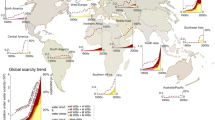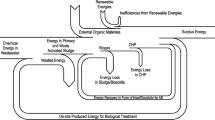Abstract
This paper intended to evaluate the performance of a new design of solar still integrated with a V-groove solar air collector. In this system, an air channel was placed under the basin to simultaneously raise the water temperature and the temperature difference between evaporation and condensation zones. The performance of this modified solar still was compared with a conventional one in terms of their productivity, cost of water production, energy, exergy, energy payback time, enviroeconomic, and exergoeconomic analysis. All the experiments were performed in the climatic conditions of Zanjan, Iran. Findings revealed that the freshwater produced in the modified system was 170% more than the traditional one. Moreover, the annual output energy and exergy of the modified still was 170% and 257% higher than the conventional one, respectively. The results also showed that integrating the solar air collector with solar still improved the energy and exergy parameters, energy payback time, and energy production factor 26, 67, 17, and 21% more than traditional solar still, respectively. Additionally, the modified solar still was found to be 40.6% more efficient than the conventional type in the Co2 mitigation. Furthermore, based on the experimental results, three characteristic equations were presented to predict the daily water production, efficiency, and Co2 mitigation of the conventional and modified solar stills based on the solar intensity and ambient temperature. Finally, a characteristic equation for instantaneous efficiency of the active still, which depends on climatic conditions and system performance parameters, was obtained.

























Similar content being viewed by others
Data availability
Data can be made available on request.
Change history
09 June 2022
A Correction to this paper has been published: https://doi.org/10.1007/s11356-022-21397-2
Notes
Phase change materials
Photovoltaic-thermal
Photovoltaic
Phase change materials
References
Abdullah AS (2013) Improving the performance of stepped solar still. Desalination 319:60–65. https://doi.org/10.1016/j.desal.2013.04.003
Aghaei Zoori H, Farshchi Tabrizi F, Sarhaddi F, Heshmatnezhad F (2013) Comparison between energy and exergy efficiencies in a weir type cascade solar still. Desalination 325:113–121. https://doi.org/10.1016/j.desal.2013.07.004
Alipanah F, Rahbar N (2018) CFD simulation and second law analysis of weir-type cascade solar stills with different number and dimensions of steps. Desalin Water Treat 104:15–27. https://doi.org/10.5004/dwt.2018.21925
Fotouhi Bafghi E, Rahbar N, Esfahani JA (2013) Productivity Improvement of a Tubular Solar Still, Using CFD Simulation. Journal of Modeling in Engineering 11(33):45–56. https://doi.org/10.22075/JME.2017.1643
Bait O (2019) Exergy, environ–economic and economic analyses of a tubular solar water heater assisted solar still. J Clean Prod 212:630–646. https://doi.org/10.1016/j.jclepro.2018.12.015
Budapest PMS (2020) Price Rankings by Country of Water (1.5 liter bottle) (Markets). Available from: https://www.numbeo.com/cost-of-living/country_price_rankings?displayCurrency=USD&itemId=13
Dehghan AA, Afshari A, Rahbar N (2015) Thermal modeling and exergetic analysis of a thermoelectric assisted solar still. Sol Energy 115:277–288. https://doi.org/10.1016/j.solener.2015.02.038
Dev R, Tiwari G (2010) Characteristic equation of a hybrid (PV-T) active solar still. Desalination 254:126–137. https://doi.org/10.1016/j.desal.2009.12.004
Elbar ARA, Yousef MS, Hassan H (2019) Energy, exergy, exergoeconomic and enviroeconomic (4E) evaluation of a new integration of solar still with photovoltaic panel. J Clean Prod 233:665–680. https://doi.org/10.1016/j.jclepro.2019.06.111
Eltawil MA, Omara ZM (2014) Enhancing the solar still performance using solar photovoltaic, flat plate collector and hot air. Desalination 349:1–9. https://doi.org/10.1016/j.desal.2014.06.021
El-Zahaby AM, Kabeel AE, Bakry AI, El-agouz SA, Hawam OM (2010) Augmentation of solar still performance using flash evaporation. Desalination 257:58–65. https://doi.org/10.1016/j.desal.2010.03.005
Hasani M, Rahbar N (2015) Application of thermoelectric cooler as a power generator in waste heat recovery from a PEM fuel cell – an experimental study. Int J Hydrog Energy 40:15040–15051. https://doi.org/10.1016/j.ijhydene.2015.09.023
Hassan H, Yousef MS, Ahmed MS, Fathy M (2020a) Energy, exergy, environmental, and economic analysis of natural and forced cooling of solar still with porous media. Environ Sci Pollut Res 27:38221–38240. https://doi.org/10.1007/s11356-020-09995-4
Hassan H, Yousef MS, Fathy M, Ahmed MS (2020b) Assessment of parabolic trough solar collector assisted solar still at various saline water mediums via energy, exergy, exergoeconomic, and enviroeconomic approaches. Renew Energy 155:604–616. https://doi.org/10.1016/j.renene.2020.03.126
Hassan H, Yousef MS, Fathy M (2021) Productivity, exergy, exergoeconomic, and enviroeconomic assessment of hybrid solar distiller using direct salty water heating. Environ Sci Pollut Res 28:5482–5494. https://doi.org/10.1007/s11356-020-10803-2
Heydari A, Rahbar N (2017) Energy and life cost analysis of a wet wall solar still with various pump working conditions. Environ Prog Sustain Energy 36:532–538. https://doi.org/10.1002/ep.12470
Ibrahim AGM, Rashad AM, Dincer I (2017) Exergoeconomic analysis for cost optimization of a solar distillation system. Sol Energy 151:22–32. https://doi.org/10.1016/j.solener.2017.05.020
Joshi P, Tiwari GN (2018) Energy matrices, exergo-economic and enviro-economic analysis of an active single slope solar still integrated with a heat exchanger: a comparative study. Desalination 443:85–98. https://doi.org/10.1016/j.desal.2018.05.012
Kabeel AE (2009) Performance of solar still with a concave wick evaporation surface. Energy 34:1504–1509. https://doi.org/10.1016/j.energy.2009.06.050
Kabeel AE, Khairat Dawood MM, Nabil T, Alonafal BE (2019a) Improving the performance of stepped solar still using a graphite and PCM as hybrid store materials with internal reflectors coupled with evacuated tube solar collector. Heat Mass Transf 56:891–899. https://doi.org/10.1007/s00231-019-02741-8
Kabeel AE, Khairat Dawood MM, Ramzy K, Nabil T, Elnaghi B, elkassar A (2019b) Enhancement of single solar still integrated with solar dishes: an experimental approach. Energy Convers Manag 196:165–174. https://doi.org/10.1016/j.enconman.2019.05.112
Karim M, Perez E, Amin ZM (2014) Mathematical modelling of counter flow v-grove solar air collector. Renew Energy 67:192–201. https://doi.org/10.1016/j.renene.2013.11.027
Khanmohammadi S, Khanmohammadi S (2019) Energy, exergy and exergo-environment analyses, and tri-objective optimization of a solar still desalination with different insulations. Energy 187:115988. https://doi.org/10.1016/j.energy.2019.115988
Kumar S, Tiwari GN (2009) Life cycle cost analysis of single slope hybrid (PV/T) active solar still. Appl Energy 86:1995–2004. https://doi.org/10.1016/j.apenergy.2009.03.005
Ladouy S, Khabbazi A (2017) Experimental investigation of different air heating methods near to the evaporation surface in closed triangular shape unit powered by solar energy, one stage – indoor experiment. Appl Therm Eng 127:203–211. https://doi.org/10.1016/j.applthermaleng.2017.08.004
Madiouli J, Lashin A, Shigidi I, Badruddin IA, Kessentini A (2020) Experimental study and evaluation of single slope solar still combined with flat plate collector, parabolic trough and packed bed. Sol Energy 196:358–366. https://doi.org/10.1016/j.solener.2019.12.027
Mukherjee K, Tiwari G (1986) Economic analyses of various designs of conventional solar stills. Energy Convers Manag 26:155–157
Nazari S, Safarzadeh H, Bahiraei M (2019) Experimental and analytical investigations of productivity, energy and exergy efficiency of a single slope solar still enhanced with thermoelectric channel and nanofluid. Renew Energy 135:729–744. https://doi.org/10.1016/j.renene.2018.12.059
Omidi B, Rahbar N, Kargarsharifabad H, Rashidi S (2020) Combination of a solar collector and thermoelectric cooling modules in a humidification–dehumidification desalination system-experimental investigation with energy, exergy, exergoeconomic and environmental analysis. Energy Convers Manag 225:113440. https://doi.org/10.1016/j.enconman.2020.113440
Pal P, Dev R, Singh D, Ahsan A (2018) Energy matrices, exergoeconomic and enviroeconomic analysis of modified multi–wick basin type double slope solar still. Desalination 447:55–73. https://doi.org/10.1016/j.desal.2018.09.006
Panchal H, Sathyamurthy R, Kabeel AE, el-Agouz SA, Rufus DS, Arunkumar T, Muthu Manokar A, Winston DP, Sharma A, Thakar N, Sadasivuni KK (2019) Annual performance analysis of adding different nanofluids in stepped solar still. J Therm Anal Calorim 138:3175–3182. https://doi.org/10.1007/s10973-019-08346-x
Parsa SM, Rahbar A, Javadi YD, Koleini MH, Afrand M, Amidpour M (2020) Energy-matrices, exergy, economic, environmental, exergoeconomic, enviroeconomic, and heat transfer (6E/HT) analysis of two passive/active solar still water desalination nearly 4000m: altitude concept. J Clean Prod 261:121243. https://doi.org/10.1016/j.jclepro.2020.121243
Rahbar N, Asadi A (2016) Solar intensity measurement using a thermoelectric module; experimental study and mathematical modeling. Energy Convers Manag 129:344–353. https://doi.org/10.1016/j.enconman.2016.10.007
Rahbar N, Esfahani JA (2013) Productivity estimation of a single-slope solar still: theoretical and numerical analysis. Energy 49:289–297. https://doi.org/10.1016/j.energy.2012.10.023
Rahbar N, Gharaiian A, Rashidi S (2017) Exergy and economic analysis for a double slope solar still equipped by thermoelectric heating modules - an experimental investigation. Desalination 420:106–113. https://doi.org/10.1016/j.desal.2017.07.005
Rahbar N, Asadi A, Fotouhi-Bafghi E (2018) Performance evaluation of two solar stills of different geometries: tubular versus triangular: experimental study, numerical simulation, and second law analysis. Desalination 443:44–55
Rajaseenivasan T, Srithar K (2016) Performance investigation on solar still with circular and square fins in basin with CO 2 mitigation and economic analysis. Desalination 380:66–74. https://doi.org/10.1016/j.desal.2015.11.025
Rajaseenivasan T, Raja PN, Srithar K (2014) An experimental investigation on a solar still with an integrated flat plate collector. Desalination 347:131–137. https://doi.org/10.1016/j.desal.2014.05.029
Rastegar S, Kargarsharifabad H, Rahbar N, Shafii MB (2020) Distilled water production with combination of solar still and thermosyphon heat pipe heat exchanger coupled with indirect water bath heater – experimental study and thermoeconomic analysis. Appl Therm Eng 176:115437. https://doi.org/10.1016/j.applthermaleng.2020.115437
Sahota L, Shyam, Tiwari GN (2017) Energy matrices, enviroeconomic and exergoeconomic analysis of passive double slope solar still with water based nanofluids. Desalination 409:66–79. https://doi.org/10.1016/j.desal.2017.01.012
Saragi JH, Napitupulu FH, Nasution AH, Ambarita H (2020) Exergy analysis of double slope passive solar still. IOP Conf Ser Mater Sci Eng 1. IOP Publishing:012005. https://doi.org/10.1088/1757-899X/725/1/012005
Sharon H, Reddy KS (2015) Performance investigation and enviro-economic analysis of active vertical solar distillation units. Energy 84:794–807. https://doi.org/10.1016/j.energy.2015.03.045
Sharshir SW, Ellakany YM, Eltawil MA (2020) Exergoeconomic and environmental analysis of seawater desalination system augmented with nanoparticles and cotton hung pad. J Clean Prod 248:119180. https://doi.org/10.1016/j.jclepro.2019.119180
Shoeibi S, Rahbar N, Abedini Esfahlani A, Kargarsharifabad H (2020) Application of simultaneous thermoelectric cooling and heating to improve the performance of a solar still: an experimental study and exergy analysis. Appl Energy 263:114581. https://doi.org/10.1016/j.apenergy.2020.114581
Singh DB (2019) Exergo-economic, enviro-economic and productivity analyses of N identical evacuated tubular collectors integrated double slope solar still. Appl Therm Eng 148:96–104. https://doi.org/10.1016/j.applthermaleng.2018.10.127
Singh DB, Yadav JK, Dwivedi VK, Kumar S, Tiwari GN, Al-Helal IM (2016) Experimental studies of active solar still integrated with two hybrid PVT collectors. Sol Energy 130:207–223. https://doi.org/10.1016/j.solener.2016.02.024
Tiwari G, Noor M (1996) Characterisation of solar stills. Int J Sol Energy 18:147–171. https://doi.org/10.1080/01425919608914313
Tiwari AK, Tiwari GN (2007) Thermal modeling based on solar fraction and experimental study of the annual and seasonal performance of a single slope passive solar still: the effect of water depths. Desalination 207:184–204. https://doi.org/10.1016/j.desal.2006.07.011
Tiwari S, Tiwari GN (2016) Exergoeconomic analysis of photovoltaic-thermal (PVT) mixed mode greenhouse solar dryer. Energy 114:155–164. https://doi.org/10.1016/j.energy.2016.07.132
Tiwari GN, Singh HN, Tripathi R (2003) Present status of solar distillation. Sol Energy 75:367–373. https://doi.org/10.1016/j.solener.2003.07.005
Yousef MS, Hassan H (2019) Assessment of different passive solar stills via exergoeconomic, exergoenvironmental, and exergoenviroeconomic approaches: a comparative study. Sol Energy 182:316–331. https://doi.org/10.1016/j.solener.2019.02.042
Author information
Authors and Affiliations
Contributions
Parisa Azari: Conceptualization, resources, performing experiments, formal analysis, investigation, data curation, writing original draft, and editing.
Arash Mirabdolah Lavasani: Conceptualization, writing-review and editing, supervision, and project administration.
Nader Rahbar: Conceptualization, writing-review and editing, supervision, and project administration.
Mohammad Eftekhari Yazdi: Supervision and project administration.
Corresponding author
Ethics declarations
Ethics approval
Not applicable
Consent to participate
Not applicable
Consent for publication
Not applicable
Competing interests
The authors declare no competing interests.
Additional information
Responsible Editor: Philippe Garrigues
Publisher’s note
Springer Nature remains neutral with regard to jurisdictional claims in published maps and institutional affiliations.
Highlights
1. Freshwater production enhanced by integrating a V-groove solar air collector into solar still.
2. The proficiency of the active solar still was experimentally compared with the passive one.
3. An improvement of 170% in distilled water was achieved for the active solar still.
4. The CPL value for the active solar still was 33% lower than passive one.
5. The exergoeconomic parameters based on energy and exergy for active solar still has been found to be 7.8 and 0.79kWh/$, respectively, at 20% rate of interest.
6. The active solar still mitigated Co2 emission more than the passive one.
7. Characteristic equations of the active solar still were extracted to predict the daily yield, efficiency, andCo2 mitigation.
Rights and permissions
About this article
Cite this article
Azari, P., Mirabdolah Lavasani, A., Rahbar, N. et al. Performance enhancement of a solar still using a V-groove solar air collector—experimental study with energy, exergy, enviroeconomic, and exergoeconomic analysis. Environ Sci Pollut Res 28, 65525–65548 (2021). https://doi.org/10.1007/s11356-021-15290-7
Received:
Accepted:
Published:
Issue Date:
DOI: https://doi.org/10.1007/s11356-021-15290-7




